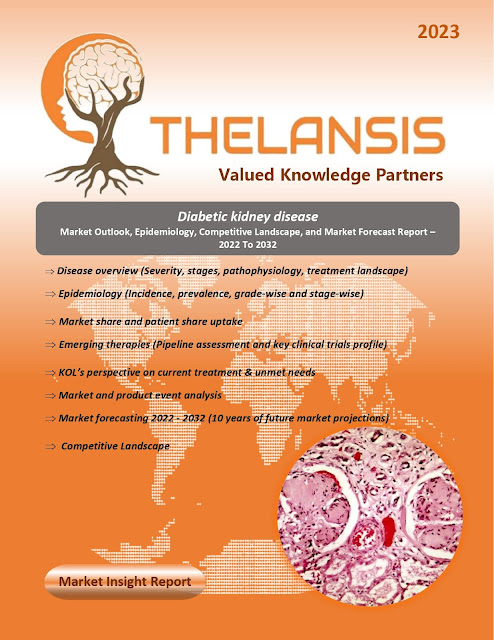Diabetic Kidney Disease – Market Outlook, Epidemiology, Competitive Landscape, and Market Forecast Report – 2022 To 2032
Diabetic kidney disease (DKD) is a leading cause of end-stage kidney disease (ESKD), affecting approximately 40% of patients with type 1 and 2 diabetes. Diabetic nephropathy is the primary cause of kidney disease in patients who require renal replacement therapy. The exact cause of diabetic nephropathy remains unknown; however, insulin resistance, genetics, hyperglycemia, and autoimmune processes may contribute. Hyperglycemia causes the production of reactive oxygen species, which activate various pathways, including protein kinase C, hexosamine, polyol, and advanced glycation end products (AGE). The resulting inflammation is characterized by increased levels of cytokines and chemokines such as IL-6, MCP-1, TGF-beta, and VEGF, leading to fibrosis, inflammation, and increased vascular permeability. Chronic tubular injury and fibrosis occur as a result of epithelial-mesenchymal cell transformation. Albuminuria results from podocytopathy, and proteinuria occurs due to systemic and intraglomerular hypertension. Proteinuria is a hallmark of diabetic nephropathy, and the absence of retinopathy makes diabetic nephropathy less likely in type 1 diabetes mellitus (T1DM) patients. Diabetic nephropathy patients risk developing acute kidney injury, and microalbuminuria is an independent risk factor for cardiovascular mortality. Most patients die from end-stage renal disease, and diabetic retinopathy is often associated with diabetic nephropathy. The prevalence of DKD in most type 2 diabetics - at any point in time - is approximately 30%-50%, and it was reported among US diabetic adults (>90% type 2).
·
This prevalence ranged between 25% in patients
younger than 65 years old to nearly 50% in age older than 65 years.
Thelansis’s “Diabetic Kidney Disease
Market Outlook, Epidemiology, Competitive Landscape, and Market Forecast Report
– 2022 To 2032" covers disease overview, epidemiology, drug utilization,
prescription share analysis, competitive landscape, clinical practice,
regulatory landscape, patient share, market uptake, market forecast, and key
market insights under the potential Diabetic Kidney Disease treatment
modalities options for eight major markets (USA, Germany, France, Italy, Spain,
UK, Japan, and China).
KOLs insights
of Diabetic Kidney Disease across 8 MM market from the centre of Excellence/
Public/ Private hospitals participated in the study. Insights around current
treatment landscape, epidemiology, clinical characteristics, future treatment
paradigm, and Unmet needs.
Diabetic Kidney Disease Market Forecast Patient
Based Forecast Model (MS. Excel Based Automated Dashboard), which Data Inputs
with sourcing, Market Event, and Product Event, Country specific Forecast
Model, Market uptake and patient share uptake, Attribute Analysis, Analog
Analysis, Disease burden, and pricing scenario, Summary, and Insights.
Thelansis Competitive Intelligence (CI) practice
has been established based on a deep understanding of the pharma/biotech
business environment to provide an optimized support system to all levels of
the decision-making process. It enables business leaders in forward-thinking
and proactive decision-making. Thelansis supports scientific and commercial
teams in seamless CI support by creating an AI/ ML-based technology-driven
platform that manages the data flow from primary and secondary sources.




Comments
Post a Comment